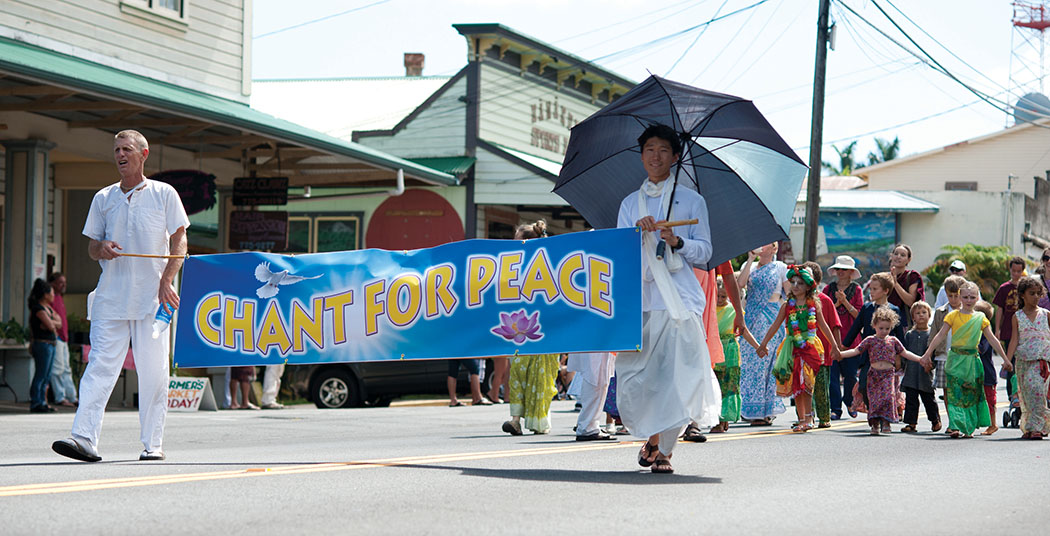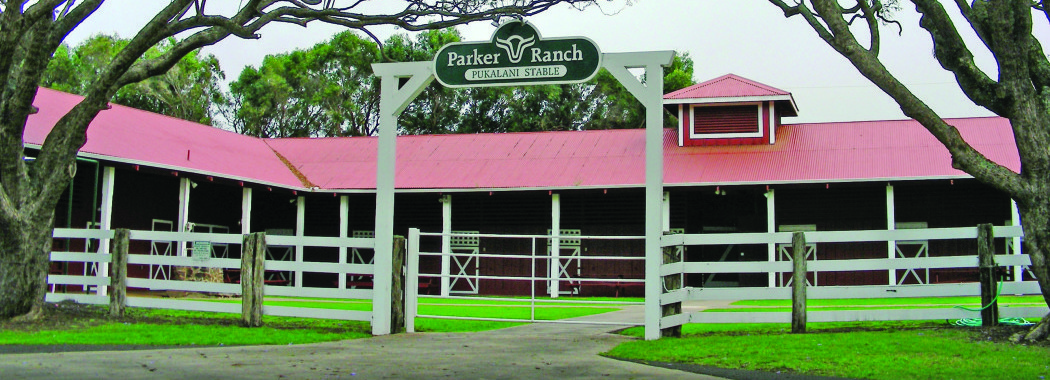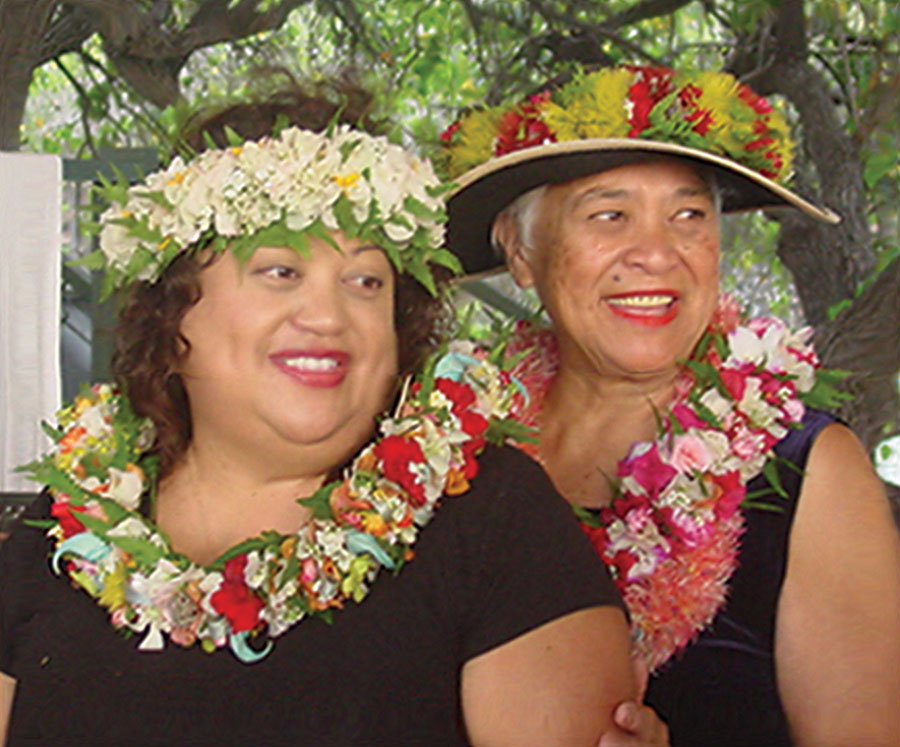
Crafting the Rhythm of Hula: Vea’s Polynesian Gifts
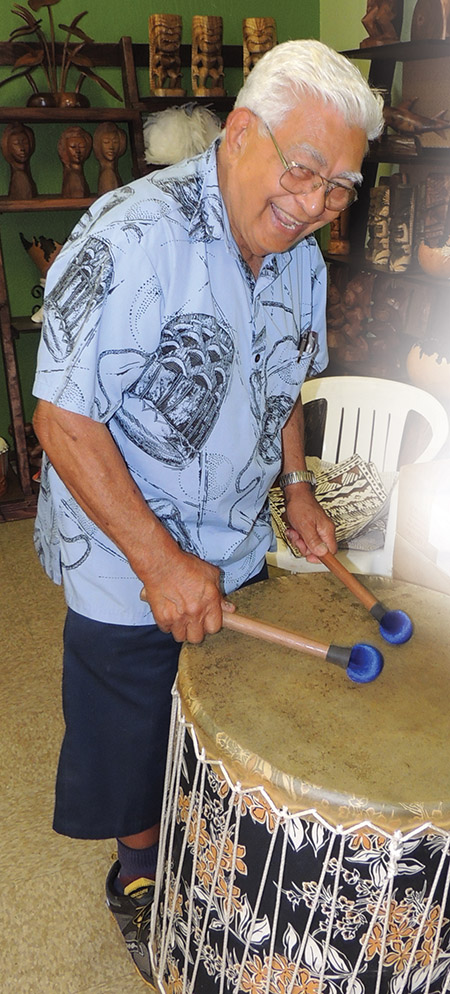
By Catherine Tarleton
I had to make an ‘ulī‘ulī for hula class. If you don’t know, ‘ulī‘ulī is a rhythm instrument, a gourd rattle, decorated with a circle of kapa cloth to which feathers are sewn. Finished, it looks kind of like a vase of flowers, and a skilled dancer will hold it by the neck, flicking the “flowers” with her wrist to mimic the wind, the surf, or the rustle of trees. It’s fun to play.
It is not fun to make.
Mine is a mess and still sits unfinished after about a year by the time this story is published. The feathers stick out all kapakahi (crooked) at different wrong angles and underneath you can see evidence of this painful experience in droplets of my actual blood from needle-poked fingers.
You should know that I used a metal needle, not a fishbone or coconut rib, and that the other materials came from a kit. And with every finger poke, every broken thread, I gained a new and bottomless respect for those who made these things back in the day.
I did not grow the la‘amia gourd on a calabash tree, nor the ali‘ipoe seeds to go inside, nor the wauke (mulberry) to pound into kapa cloth, nor the dye plants to decorate the kapa with. It wasn’t me that pounded the kapa, or made the ‘ohe kapala dye stamp from bamboo, which I also did not grow. And I don’t know anyone with patience of the kia manu—the bird catcher who lured a living bird with sticky resin on a branch—to pluck a few feathers, let it go, and repeat until enough were gathered.
So what I did was easy, relatively, and still it’s no surprise that when I walked into Vea’s Polynesian Gifts in Kapa‘au, I was immediately drawn to the ‘ulī‘ulī. Shelves full of them—in vivid crimson and gold, rows of pure white with what must have been angel feathers, mated pairs of the kapa kind—like I tried to make.

“Oh, my God,” I said, petting one’s glossy feathers. “This is amazing.”
Master crafter Ika Vea laughed. I told him about my struggles. He told me about his shortcuts. I will not tell them all to you.
I will tell you that his shop is filled floor-to-ceiling with hula’s rhythm instruments, all things to beat, slap, shake, tap, rattle, click together, and pound on the floor. Pahu (drums) tall-to-small with stretched skin heads stand at attention in the back. Here, a grove of thin Tahitian Toere, log drums. There, a display of knee drums, polished half-coconut pūniu with sennit lashing, and kilu, the small drum mounted on a stand, played with the left hand while the right beats another, bigger drum.
Baskets hold ‘ili‘ili, the water-smoothed stones played like castanets, the pū‘ili, raspy bamboo sticks, slit at one end for a brushlike sound, and the kāla‘au, the dancing sticks of different sizes. Underneath, large heke (double gourd drum) sit on the floor. High shelves hold lines of grinning or grimacing tiki masks, carved from various shades of hau wood, overseeing everything like gargoyles. To the side, sturdy poi boards and stone pounders.
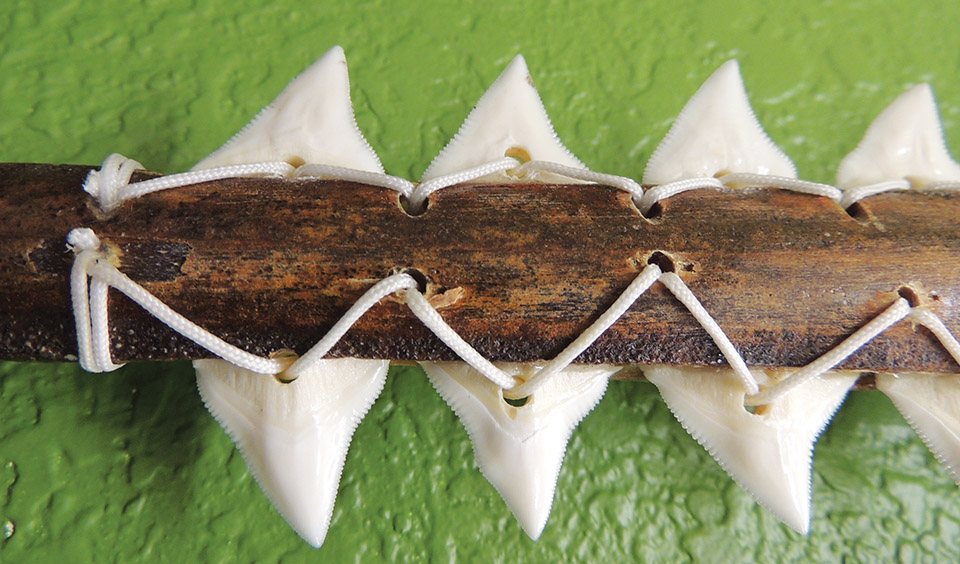
In one corner, formidable weapons hang on the wall. Pāhoa (daggers fitted with marlin bills), leiomano (clubs edged with sharks’ teeth), and a newa la‘au club of heavy wood, stone fist lashed to it like a hammerhead. “This one, I make special for the ladies,” he says. “I tell them if your husband is mean, take care of him.” His laugh is infectious, musical.

I am thinking these beautiful, finely crafted weapons—implements of battle—are not so different from the instruments of hula. The martial art, lua, can be a graceful discipline. It’s not hard to image the well-buffed kāne of Merrie Monarch wielding these on kahiko night.
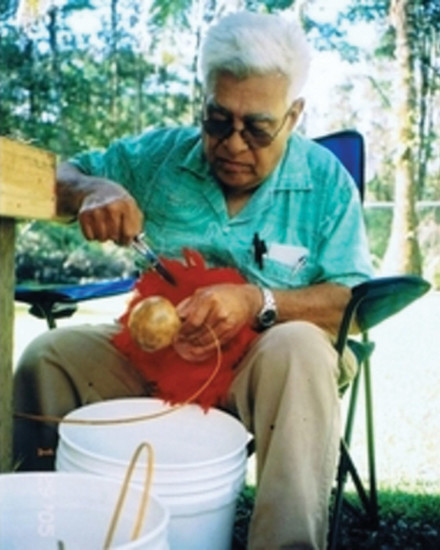
It’s all about the rhythm. Even the everyday things: poi pounding, kapa beating, paddling canoe. What did the Hawaiians hear then that we do not now? What heartbeat, what different drum, led them to create such masterful instruments to dance with, to wage war, to prepare food? My mind wanders while Ika greets customers. Young honeymooners it looks like, wide-eyed and wondering about the shamanic objects on the walls and the grandfatherly welcome from their craftsman.
Ika is originally from Tonga, “The Friendly Islands,” an independent sovereign nation in the South Pacific. His story doesn’t start in one place. It actually kind of starts with faith, about 100 years before he was born.
Maybe because Hawai‘i is so close to Heaven. Maybe that’s why the Church of Jesus Christ of the Latter Day Saints decided, in 1865, to purchase 6,000-acre Laie plantation that would grow into O‘ahu’s Polynesian Cultural Center (PCC) 98 years later.
And maybe that’s what inspired a young Ika Vea to answer the church’s call and travel from his home in Tonga to help build the South Pacific villages of PCC in 1960. Ika worked as an electrician while attending school at night, where he met future wife Puanani Pule. Together they traveled to the mainland, started their family, and eventually returned to her home on Hawai‘i Island. There, Ika went to work at Kohala Sugar Company, the plantation founded by Reverend Elias Bond in 1863 to support his church and schools, just about the same time LDS Church purchased its plantation tract in Laie.

“I worked in the lab,” says Ika, “but I never took chemistry in school.” His job was to test the sugar juice, and make sure the ratio of water and sugar would crystalize properly, to make uniform grains of refined sugar in the screening process. “On the plantation, they gave me books and made me follow this guy around about a week,” he says. “My wife had to read me the books and show me how to use the typewriter.”
When Kohala Sugar closed in 1973, PCC offered him the chance to come back, so Ika flew over for an interview. The O‘ahu he remembered was already overgrown and bustling and so Ika decided to come home.
“On the airplane on the flight back, I looked at the magazine and saw an ad for a hula supply company—the only hula supply company in the state of Hawai‘i, and I thought ‘I want to do that.’”
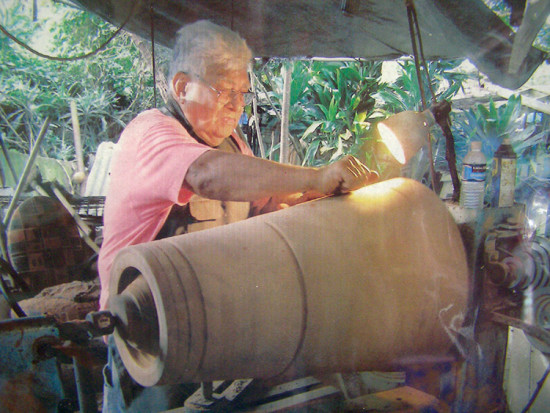
Eager to learn, though not a musician or a hula student himself, he sought out help from kūpuna and kumu hula in the community. Even though the student was ready, this time the teacher did not appear. Determined, Ika came up with an ingenious plan.
“Nobody wanted to show me,” says Ika. “So, I put an ad in the paper for ‘Repair Broken Hula Implements’ and I got all kinds of stuff!”
Ika knew if he could take the instruments apart, he could discover how they were created. And because they were already damaged, there was no risk to the owner. Soon, he was inundated with drums and gourds, shakers, rattlers, and more.
Trial and error was key. Sometimes, he found materials that served the purpose more durably than the original. He found that rawhide from Texas was more readily available than hard-to-find sharkskin for drum heads. Braided rope lasted longer than lauhala for the pūniu “drumstick.” He learned that thicker-skinned gourds from the west coast hold up better than Hawaiian gourds for the large ipu heke. “The kumu hula really slap ‘em,” says Ika.

He uses kapa cloth from Fiji or Tonga to trim mahiole (warriors’ helmets) and other items.
“Kapa from Fiji is stiffer,” says Ika. “They really pound it. When you wake up in the morning, you hear all this tapa pounding all around, and they make plenty in one day.”
Ika long ago lost count of how many instruments he has repaired. As many modern crafters do, he uses drills and other power tools to facilitate his work, often coming up with creative solutions to problems. One broken marlin woodcarving, for example, was repaired with an actual marlin bill, sourced from a Kona fish market.
“I stopped to buy fish and I saw these guys rolling out a barrel with the marlin bills in it,” says Ika. “The owners belong to the same church I do, and I knew them so I said, ‘Don’t throw that away!’”
Sometimes he improvises with the weapons, attaching a marlin bill and feathers to a traditional pāhoa dagger, or merging the leiomano with a dagger or club. He might borrow a Maori design for handles or line the threatening edges of hooks with sharks’ teeth. He also likes to carve supersized milo or monkeypod fishhooks lashed with coconut sennit. “The big hooks are for decoration, not fishing,” says Ika.

His ipu have traveled around the world. His drums serve as prizes for the Merrie Monarch winners.
“I’ve been in Merrie Monarch from the start,” says Ika. “We [the crafters] started in the old Butler Building. The floor was gravel, and at the end of the day, they tied up the door with wire.”
Ika finds inspiration wherever he goes. “I go to most of the fairs and look around for good ideas,” he says. “When I go to Honolulu or any place to get Hawaiian stuff—in Kona at Hulihe‘e Palace, or displayed in the hotels. If it looks nice to me, I take pictures, come home and try to make it.”
Ika’s eyes follow the height and breadth of the shop, remembering. In their long marriage of 52 years, he and Puanani traveled to many of the places represented in the shop: Fiji, New Zealand, the Cook Islands. At her memorial service, Ika put one of his drums and ‘ulī‘ulī on display in the chapel. I wondered if he had any advice for the honeymooners.
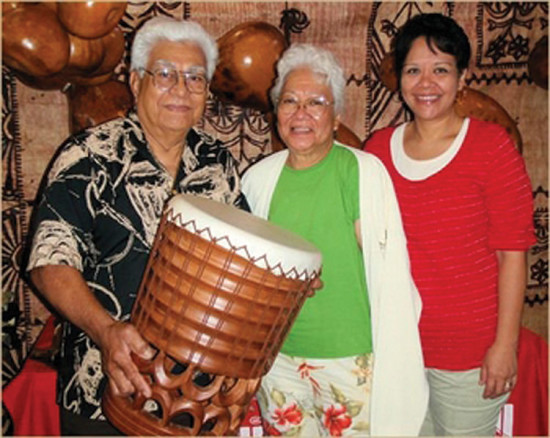
“Don’t put up with anything unnecessary. Try to settle everything between you two,” he says. “If she wanted to do something and I didn’t like it, I said ‘go ahead and I will help you,’ and she did the same thing to me. If it didn’t work out, we said, ‘Well, I tried to help you!’”
Before we part, he offers more advice. “Anything you spend time on, make it nice,” he says. “I want to make a big drum and make it nice. “I’m looking for a coconut palm, 35-36 inches high so I can make some design.” He nods, already imagining. It’s time for me to go, to leave him with his thoughts and his customers.
“Take ‘ulī‘ulī with you—take a pair!” he says with his amazing smile. I tell him thank you, I cannot; I’ll come back and buy if I can’t bring myself to finish mine. He won’t take no for an answer. There is a single, unmatched ‘ulī‘ulī on the shelf. Ika Vea smiles.
I step outside and can’t resist, giddily rattling and fluttering feathers in the bright Kohala sunshine: shaky-shaky tap, tap, tap, shaky-shaky tap, tap, tap. Elated for a second, I feel like a hula dancer. I feel the rhythm. ❖
Contact Ika Vea: Hula-Instruments.com
Contact writer Catherine Tarleton: catherinetarleton@gmail.com
